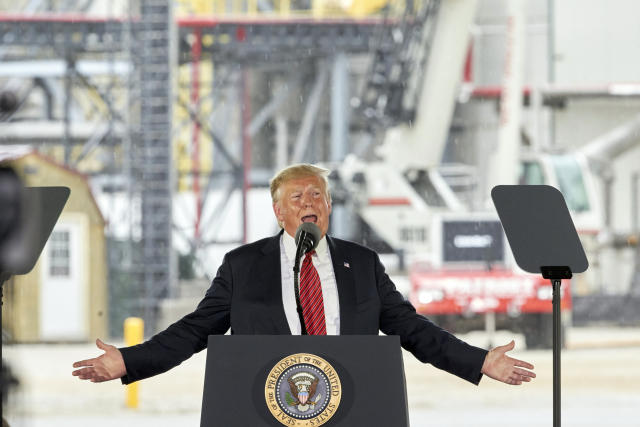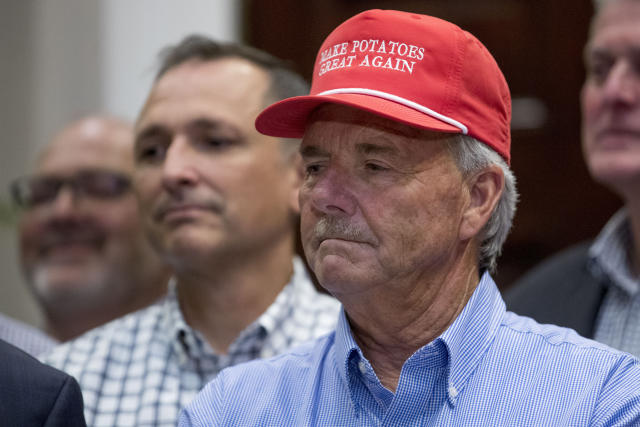‘If you’re a good worker, papers don’t matter’: How a Trump construction crew has relied on immigrants without legal status
By Joshua Partlow and David Fahrenthold August 9, 2019

A Trump-owned construction company that has employed undocumented immigrants did work at the Trump National Golf Club in Sterling, Va. (Salwan Georges/The Washington Post).
OSSINING, N.Y. — For nearly two decades, the Trump Organization has relied on a roving crew of Latin American employees to build fountains and waterfalls, sidewalks and rock walls at the company’s winery and its golf courses from New York to Florida.
Other employees at Trump clubs were so impressed by the laborers — who did strenuous work with heavy stone — that they nicknamed them “Los Picapiedras,” Spanish for “the Flintstones.”
For years, their ranks have included workers who entered the United States illegally, according to two former members of the crew. Another employee, still with the company, said that remains true today.
President Trump “doesn’t want undocumented people in the country,” said one worker, Jorge Castro, a 55-year-old immigrant from Ecuador without legal status who left the company in April after nine years. “But at his properties, he still has them.”
Castro said he worked on seven Trump properties, most recently Trump’s golf club in Northern Virginia. He provided The Washington Post with several years of his pay stubs from Trump’s construction company, Mobile Payroll Construction LLC, as well as photos of him and his colleagues on Trump courses and text messages he exchanged with his boss, including one in January dispatching him to “Bedminster,” Trump’s New Jersey golf course.
Another immigrant who worked for the Trump construction crew, Edmundo Morocho, said he was told by a Trump supervisor to buy fake identity documents on a New York street corner. He said he once hid in the woods of a Trump golf course to avoid being seen by visiting labor union officials.
Jorge Castro, an Ecuadoran immigrant, works at the Trump National Golf Club in Sterling, Va., in October 2016. (Courtesy of Jorge Castro)
The hiring practices of the little-known Trump business unit are the latest example of the chasm between the president’s derisive rhetoric about immigrants and his company’s long-standing reliance on workers who cross the border illegally.
And it raises questions about how fully the Trump Organization has followed through on its pledge to more carefully scrutinize the legal status of its workers — even as the Trump administration launched a massive raid of undocumented immigrants, arresting about 680 people in Mississippi this week.
In January, Eric Trump, one of the president’s sons and a top Trump Organization executive, told The Post that the company was “making a broad effort to identify any employee who has given false and fraudulent documents to unlawfully gain employment,” saying any such individuals would be immediately fired.
He also said the company was instituting E-Verify, a voluntary federal program that allows employers to check the immigration status of new hires, “on all of our properties as soon as possible.” And the company began auditing the legal status of its existing employees at its golf courses, firing at least 18.
But nothing changed on the Trump construction crew, according to current and former employees.
A spokeswoman for the Trump Organization said Mobile Payroll Construction is enrolled in E-Verify for any new hires. The company is still not listed in the public E-Verify database, which was last updated July 1.
The company did not directly respond to requests for comment about the legal status of the Mobile Construction workers, but said in a statement that “since this issue was first brought to our attention, we have taken diligent steps, including the use of E-Verify at all of our properties and companies.”
“Those efforts continue and where an employee is found to have provided fake or fraudulent documentation to unlawfully gain employment, that individual will be terminated. Fortunately, among the thousands of individuals employed by our organization, we have encountered very few instances where this has occurred,” the statement said.
The White House declined to comment.
The president, who still owns the Trump Organization but has turned over day-to-day operations to his eldest sons, said last month that he does not know if it employs workers who entered the country illegally.
“Well, that I don’t know. Because I don’t run it,” Trump told reporters. “But I would say this: Probably every club in the United States has that, because it seems to me, from what I understand, a way that people did business.”
Since January, The Post has interviewed 43 immigrants without legal status who were employed at Trump properties. They include waiters, maids and greens-keepers, as well as a caretaker at a personal hunting lodge that his two adult sons own in Upstate New York.
In all, at least eight Trump properties have employed immigrants who entered the United States illegally, some as far back as 19 years, The Post has found.
As president, Trump has launched a crusade against illegal immigration, describing Latino migrants as criminals who are part of an “invasion.” Such remarks drew renewed criticism after Saturday’s mass shooting in El Paso, which is under investigation as a hate crime targeting Mexicans and immigrants.
While poverty and violence have pushed thousands to leave Latin America, U.S. businesses that employ undocumented workers are also a major driver of illegal immigration, experts say.
By employing workers without legal status, the Trump Organization has an advantage over its competitors, particularly at a time when the economy is strong and the labor market tight, according to industry officials. Undocumented employees are less likely to risk changing jobs and less likely to complain if treated poorly.
“Nobody’s going to go and complain and say, ‘He’s not providing me with health insurance. He’s not providing me with this or that,’ ” said Alan Seidman, who heads an association of construction contractors in New York’s Hudson Valley, where Trump has a golf course. “They stay below the radar.”

Trump’s helicopter at Trump National Doral in February 2013. (Jorge Castro)
The laborers hired by the Trump construction unit — several of whom live in suburbs north of New York City — are typically dispatched by Trump construction supervisors to different jobs, driving sometimes hundreds of miles to a golf course or resort, according to the current and former employees. Over the years, some passed weeks or months away from home, bunking in buildings at Trump’s properties, they said.
Their supervisors have paid little attention to their immigration status, even after Trump launched a campaign built around the threat of immigrants and then used his presidency to crack down on border crossings, workers said.
“If you’re a good worker, papers don’t matter,” Castro said.
Trump interacted personally with some of the construction workers before he was president — greeting employees by name and commenting on minor details of their work, according to Luis Sigua, an immigrant from Ecuador who is still part of the crew. Sigua posted a photo in December 2014 on his Facebook page of himself standing on a golf course next to Trump, who is grinning and giving a thumbs-up.
Sigua declined to share his immigration status but confirmed that some members of the construction unit did not have proper documentation: “Some yes, some no.”
“Politics is nothing to me,” he added. “The work is everything.”
‘Nobody had papers’

A team of immigrant laborers helped renovate the Trump National Golf Club in Briarcliff Manor, N.Y., former workers said. (Seth Wenig/AP)
Trump’s itinerant construction crew evolved from an outfit that used to be run by Frank Sanzo, an Italian American stonemason from Yonkers who met Trump in the late 1990’s.
Sanzo was building a stone wall at the Westchester County home of former New York Knicks basketball coach Rick Pitino when Trump stopped by to talk to him one day, Sanzo recounted in an interview last month at his home in Yonkers, N.Y.
“I’m Donald Trump,” Sanzo recalled Trump telling him.
“I know who you are,” Sanzo said he replied.
Trump had purchased a country club out of foreclosure in Briarcliff Manor, N.Y., in 1996 and began renovating the golf course and building dozens of homes and condominiums. The project required extensive masonry work to build the stone walls, chimneys and columns on the clubhouse and new homes. Sanzo said Trump hired him to oversee a crew of immigrants who worked on the project for several years.
Morocho said he was one of those laborers. He joined the crew of roughly 15 people in 2000. He said he earned $15 an hour, working Monday through Saturday.
“Nobody had papers,” Morocho said.
In fact, Morocho recalled, Sanzo instructed the crew to buy fake Social Security numbers and green cards in New York so they would have something to put in the Trump Organization files. Morocho said he bought his papers for $50 in 2002.
“Frank said, ‘You can go buy a social in Queens. They sell them in Queens. Then come back to work. It’s no problem,’ ” Morocho said. “He knew.”
In 2002, Morocho recalled, New York labor union officials visited Trump’s Westchester golf club to see the construction site and Sanzo told the immigrant crew to hide for a couple of hours until they left. “We stayed behind some trees,” he said.
In a phone interview this week, Sanzo said he did not remember Morocho.
When asked whether he told employees to buy fake documents, Sanzo’s wife, Bernice, interrupted: “How would Frank know where to get that stuff?”
Sanzo added, “They can get them on the street, too.” He did not directly address the question.
During the interview at his home last month, when asked about the legal status of his workers, Sanzo replied: “Most of my guys were legal.”
He was interrupted by his wife. “Do not answer any questions, because it’s going to be misleading,” Bernice Sanzo admonished her husband. She told two Post reporters: “Trump was not involved in that, in the hiring. My husband was.”
“Most of them were legal,” Frank Sanzo said again.
He said he often hired immigrant workers who returned to their home countries and needed to be replaced and that he accepted the documents they gave him.
“They gave me a social and a license. I put them on the payroll,” Sanzo said. “I don’t know if they were legal or not.”
The longtime stonemason, who retired in 2014 and is now blind, spoke fondly about his work for Trump and their trips together to Mets and Yankees games.
Sid Liebowitz, who was the Trump Organization’s director of purchasing from 2004 to 2013, said he worked closely with Sanzo on many of his jobs — supplying materials, but not dealing with hiring or payroll.
Although Trump often had very detailed input on Sanzo’s projects, Liebowitz said he believes Sanzo did not consult the real estate developer about his employees.
“If he was hiring people that were illegal . . . Donald certainly wouldn’t know,” Liebowitz said. “Because Donald was in New York and Frank was traveling around the country.”
As Trump expanded his golf course holdings, he tapped Sanzo’s team to assist with rock walls, fountains and cart path bridges, according to building permits and former workers. The construction crew sometimes stayed for months on a property, bunking in buildings on-site or in Trump’s hotels, former workers said.
“I used to take the crew state to state,” Sanzo said.
At the Trump golf course in Sterling, Va., Sanzo’s workers built a $35,000 man-made waterfall with an observation deck overlooking the Potomac River in 2011, according to Loudoun County building permits. Building permits with Sanzo’s name also show his laborers built a $35,000 retaining wall and a $165,000 pool house for the club in 2011.
Sanzo appears in a Trump Organization “before and after” video from 2015 that showed Trump’s son Eric discussing planned renovations for the Trump Winery near Charlottesville.
As part of that project, Sanzo’s team helped renovate the previous owner’s carriage house into a wedding venue and convert the estate’s main house into a boutique hotel, according former workers and winery employees. While on the job, the crew lived in a staff house inside the winery’s gated property, cooking their own meals, according to former workers.
To the English-speaking bosses, Sanzo’s workers were reliable but largely anonymous.
“I think they were Ecuadoran,” said one former manager at Trump’s Westchester club who recalled seeing them monthly and spoke on the condition of anonymity to avoid retribution. “They were just known as ‘Sanzo’s crew.’ ”
In May 2015, as Trump began ramping up his presidential run, the construction crew got a new legal name: Mobile Payroll Construction, a new company that was registered by a Trump executive, according to corporate filings. The sole owner is Trump, according to his personal financial disclosures.
The workers said little changed except for their paychecks, which once came from other Trump entities and now came from Mobile Payroll Construction. A Trump Organization construction manager named John Gruber, who had taken over the team after Sanzo retired, continued as their boss. Gruber did not respond to requests for comment.
Early this year, amid news reports that Trump’s clubs employed workers without legal status, the Trump Organization began firing them from its golf courses.
Among those let go was Morocho, who by then had left the construction crew for a full-time maintenance job at Trump’s Westchester golf club.
But at Mobile Payroll Construction, there was no scrutiny of the workers’ immigration status, according to Castro. He said his bosses didn’t even mention it.
“It was like it didn’t happen,” he said.


 Getty Images
Getty Images


